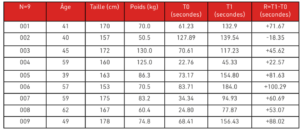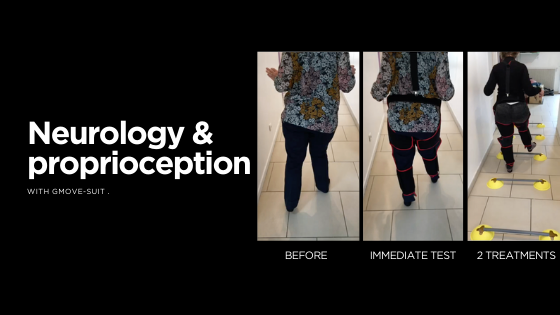In addition to muscular work, tests were conducted on patients with various neurological or psychomotor disorders. Here again, the initial reactions were very positive and offer a new realm of possibilities for the GMOVE-SUIT.
Part 1 : KILLY CHAIR – PRACTICAL CASE STUDY EHLERS-DANLOS SYNDROME BY FRÉDÉRIC MARCHAND
EHLERS-DANLOS SYNDROME
Ehlers-Danlos syndrome (commonly called EDS) is referred to as a rare genetic malady, but according to studies, it affects 1 million people in France. This disorder manifests in very different ways according to the patient. Physiotherapists are faced with patients in a lot of pain that fluctuated greatly, but was still highly disabling in terms of quality of life. We have invited the national Ehlers-Danlos association, SED1+, to participate in a protocol to test the GMOVE-SUIT to measure the direct effects with the Killy test.
THE TEST: KILLY CHAIR EXERCISE (WITH AND WITHOUT)
Method
9 patient volunteers, from 39 to 62 years old participated in the GMOVE-SUIT protocol (H: 166.11 12 cm; weight 83.52 44 kg) at 48 hour intervals under the same conditions. They were asked to hold the position as long as possible during the Killy test (time expressed in seconds). First, a calibration phase was needed to determine the right pressure (according to the EVA pain scale) based on the type of EDS. A pressure of 90 mmHg was deemed sufficient for two forms of EDS (vascular and hypermobile). Next, patients were brought to a kinesiology clinic to conduct the Killy test without the GMOVE-SUIT. After the test, each patient was able to wear the GMOVE-SUIT for 20 minutes to learn about the device. These same patients returned 48 hours later. They performed the same test, but while wearing the GMOVE-SUIT.
Results
Out of 9 participants, only one had a result less than T0, which could be explained by severe fatigue on the day of the T1 test. For the 8 others, the results proved to be very positive (table 1). Aside from the excellent results (Average: + 56.11 seconds), there was an unexpected result– based on statements by the subjects and those around them, their quality of life (unmeasured, but declarative) was improved considerably. The subjects stated they were in much less pain on a daily basis and sessions at their physiotherapists were optimized
CHAIR EXERCISE: THE PATIENTS HELD THE POSE FOR TWICE AS LONG. THIS WAS MUCH MORE COMFORTABLE FOR THE PATIENTS

Conclusion
In a sample EDS patient, the GMOVE-SUIT demonstrated effectiveness both in motor performance as well as in daily quality of life. It would be interesting to send a validated questionnaire regarding quality of life to measure subjects’ statements.
The GMOVE-SUIT’s contention and mobility features are tool which optimizes the quality of patient care. Highly conclusive tests were also conducted at physiotherapist clinics, which have encouraged us to continue our testing with various disorders.
Ancillary Observation
The effects on patients with EDS were very surprising during session as mobility increases and the effects continue without the GMOVE-SUIT for 48 hours post-session

